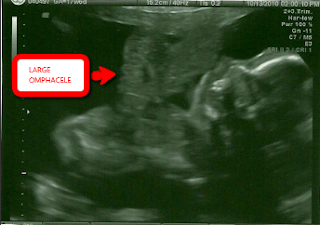Images:
Image #1: SAG fetal spine (where is the cervical spine??? It’s on a different plane…YIKES)

Image #2: Coronal/ left fetus
Image #3: SAG midline fetal profile/thorax
Findings: U/S shows large anterior midline thoraco-abdominal wall defect with ectopia cordis and large ompahlocele. The spine has the appearance of severe scoliosis and extreme curvature in the thoracic portion, suggesting kyphosis. The amniotic fluid is quite generous at 26.4cm. The umbilical looked extremely short, but precise length measurement could not be obtained. Fetus showed little to NO movement. Follow up MRI confirmed the following:
1. Kyphoscoliosis
2. Ectopia cordis,
3. Polyhydramnios
4. Large omphalocele (containing liver, stomach, spleen, and almost all of the bowel) By MRI, omphalocele appears to be contiguous with the uterine wall (This is a very important finding that could not be determined with Ultrasound).
Previous to MRI, the diagnosis was suspected to be Pentralogy of Cantrell, but the supplementary MRI has led to a different diagnosis…. (Hint: Actual diagnosis is often a differential for Pentralogy of Cantrell)
1. Kyphoscoliosis
2. Ectopia cordis,
3. Polyhydramnios
4. Large omphalocele (containing liver, stomach, spleen, and almost all of the bowel) By MRI, omphalocele appears to be contiguous with the uterine wall (This is a very important finding that could not be determined with Ultrasound).
Previous to MRI, the diagnosis was suspected to be Pentralogy of Cantrell, but the supplementary MRI has led to a different diagnosis…. (Hint: Actual diagnosis is often a differential for Pentralogy of Cantrell)



11 comments:
I believe this case is a body stalk anomaly (limb-body wall complex). There is the large abdominal wall defect with the protusion of the organs and the spinal deformity. In addition, ectopia cordis is present and I believe a heart defect. There is also Polyhydraminos. It is also a differential for Pentalogy of Cantrell.
Hello tia
I am agree with alexia . I also think that it is a body stalk anomaly.
Body stalk anomaly is a rare, sporadic developmental
abnormality reported to have an incidence of 1 in
14 000–42 000 pregnancies in a Scottish population. Due to its
rarity, the occurrence of body stalk anomaly in multiple
gestations has only been described in case reports4–7.
Body stalk anomaly is usually characterized by the
presence of a major anterior body wall defect, limb
deformities, kyphoscoliosis, an absent or short umbilical
cord and/or craniofacial defects.
The differential diagnosis of body stalk anomaly
includes other fetal abdominal wall defects such as
amniotic band syndrome , gastroschisis , pentalogy of Cantrell (sternal, pericardial,
diaphragmatic defects; ectopia cordis; large omphalocele),and
Beckwith–Wiedemann syndrome.
Zouliath
Oh my, this poor baby :( It's too bad she did not seek prenatal care earlier. What is the standard course of "treatment" for a condition like this for the mother?
do you know Body stalk anomaly represents a set of disruptive abnormalities having in common the failure of closure of the ventral wall, characterized by a severe body-wall defect (thorax, abdomen or both), evisceration of the abdominal organs into an amnioperitoneal sac and a shortened or absent umbilical cord. There is also a failure of fusion of the amnion and chorion.
You all are correct... this baby has been diagnosed with Limb-body-wall complex or body stalk anomaly. The parents of this child have bravely decided to carry this sweet little girl to full term and give her a chance at life outside of the womb. Surgery will be neccesary ASAP, but baby does not have a chance of surviving more than a year (average is less than 1 month). Surprisingly enough, the baby is physiologically normal within the womb. Along with the MRI, this little one had a fetal echo which showed a perfectly functioning heart. This whole case was horribly sad, but educationally very interesting. Can anyone discuss possible differentials for the presentation of this baby???
Tia, it is interesting case study. It is awful. The differential diagnosis for body-stalk anomaly include isolate omphalaocele, isolate gastroschisis, short umbilical cord and also limb-body complex too. Some consider body-stalk anomaly can be a sever form of amniotic band syndrome
Wow, I wasn't at all familiar with this abnormality. I found out that this is the rarest of all of the abdominal wall defects. The nuchal tranluscency is often increased and severe scoliosis develops as a result of abnormal attachment of the fetus to the placenta.
Interesting and sad!
According to my research it had been reported that there is no know reoccurrence risk and this anomalie can be predicted through a simple blood test upon pregnancy when the maternal serum alpha-fetoprotein is high. This condition was first described by. Van Allen et al in 1987 and it has been suggested that there are two forms of this anomalie one with cranial defects and one with out. I think this baby has the kind where there were no cranial defects. I got my information from http://www.pediatriconcall.com/fordoctor/casereports/limb.asp
Limb-body wall complex seems to have an endless list of related signs and symptoms including intrauterine amputations,exencaphaly, encephalocele, etc. Complications include stillbirth and spontaneous abortion. Interesting case...I have never heard of this before.
This anomaly is rare and its occurence is less than 1% and in some cases are genetic. They also are associated with beckwith-weidermann syndrome and chromosal abnormalities like Trisomy 13 and 18
Wow you all really did your research!!!! Great job everyone! Hopefully none of us will ever see a case of this ever again!!
Post a Comment